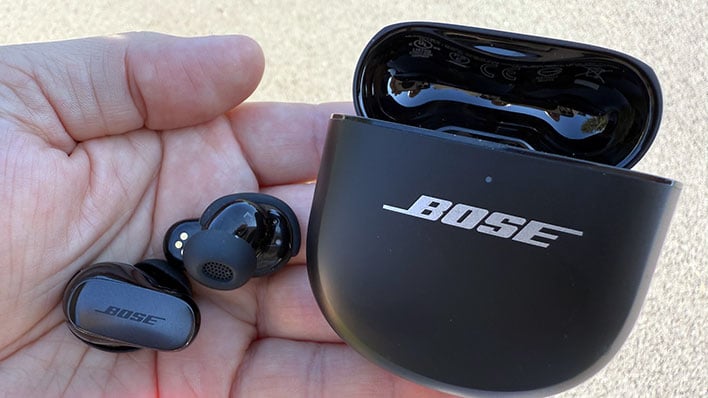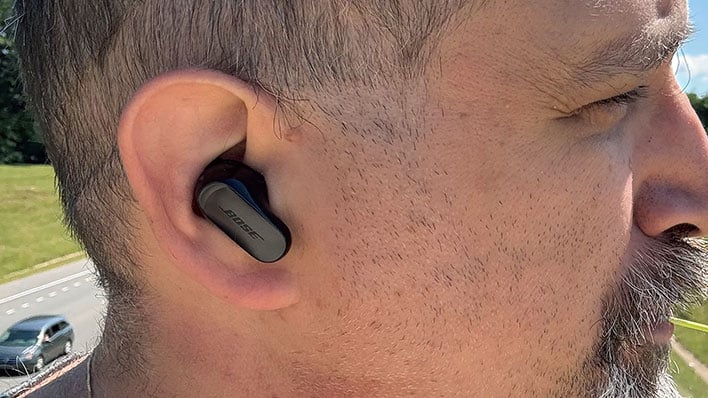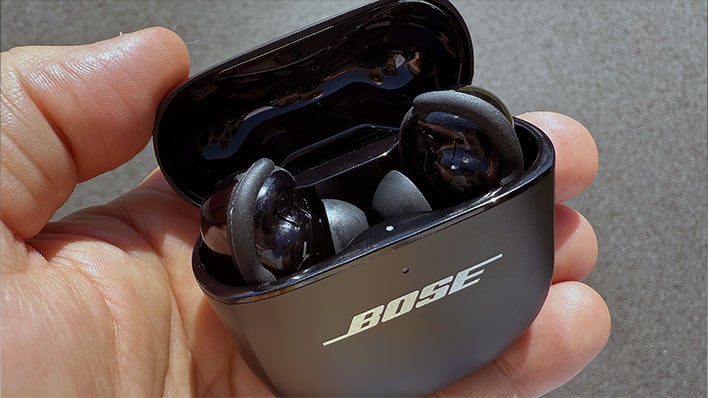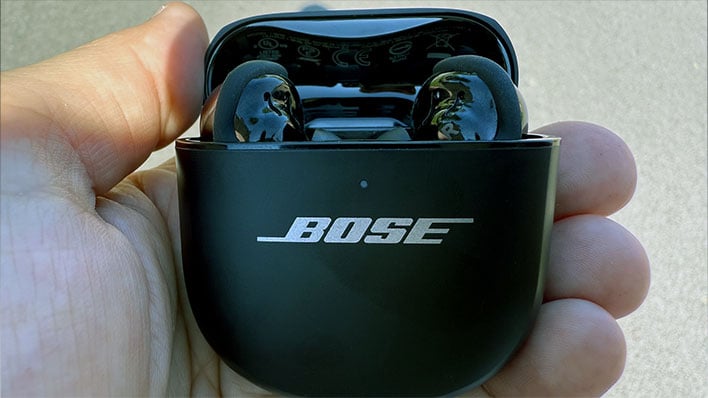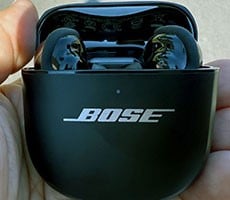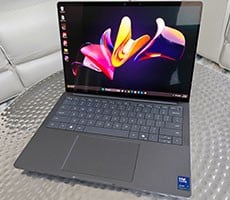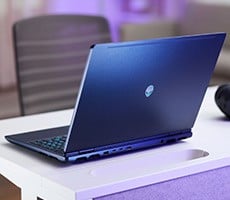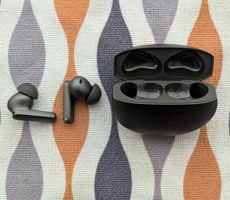|
Bose QuietComfort Ultra Earbuds (2nd Gen): MSRP $299
Bose's QuietComfort Ultra (2nd Gen) earbuds are the total package, delivering fantastic sound and first-rate ANC in a comfortable design.
|
|
|
- Comfortable Design
- Balanced Audio
- Bass Hits Hard If You Want It To
- Top Notch ANC
- SpeechClarity Feature Is An Added Bonus
|
- Premium Price
- Battery Life Same As First-Gen
|
|
Anyone who has shopped for premium earbuds or headsets with active noise cancellation has likely had Bose on their radar, and if not, they should. Bose's audio products are consistently praised for delivering some of the best active noise cancellation (ANC) in the business, to which we can attest. Bose is not the only player making waves, though, and the question is whether its new and updated 2nd Gen QuietComfort Ultra ($299) in-ear wireless earbuds are another viable option for those seeking high fidelity audio and class-leading ANC. Spoiler: the answer is a resounding "yes".
The other question is whether or not they're worth the premium launch price.
At $299, these aren't cheap earbuds by any stretch of the imagination. However, they do offer some notable upgrades and refinements over the first-gen QuietComfort Ultra earbuds, as well as features not found on the more affordable
OnePlus Buds 4 we reviewed, such as wireless charging. We'll get into the value proposition in a bit, but first let's take a deeper dive into what Bose's newest earbuds offer.
Bose QuietComfort Ultra Earbuds (2nd Gen) Design And Comfort
Physically, Bose's second-generation flagship earbuds look nearly identical to the previous generation model, but there are some subtle design changes. Chief among them is the introduction of a rubberized guard to prevent ear wax from building up on the buds. Bose includes three sets of ear tips (small, medium, and large), each with their own rubberized ring. The rings don't add anything to the overall comfort level, but they don't take anything away, either.
The earbuds themselves otherwise retain the same familiar design with a stubby, oval-shaped stem flanked by an angled tip that fits snugly in the ear canal. It's a decidedly different aesthetic than more stick-shaped earbuds like Apple's AirPods and
Samsung's Galaxy Buds3, both of which are far more slender. However, while chunkier, the QuietComfort Ultra earbuds (2nd Gen) don't feel bulky or look silly while wearing them.
They also stay put, more so than AirPods in our testing, making them suitable for running, jogging, and workouts in general. You still might prefer a set of earbuds with wraparound hooks if you tend to violently jostle your head while exercising, but we suspect most people won't have an issue with these earbuds.
As for color options, we received the Black model for review, which is glossy and looks sleek. You can also get them in White Smoke, Midnight Violet, and Deep Plum colorways, each with a charging case to match.
Color options aside, the overall build quality feels deserving of a premium designation. These earbuds don't feel cheap. And compared to the original AirPods Pro, the QuietComfort Ultra (2nd Gen) get a slight edge in overall comfort. We haven't tested the AirPods Pro 3 yet, but we suspect the feel isn't much different, with Apple sticking to the same general design language with each new iteration.
Curiously enough, while the QuietComfort Ultra earbuds (2nd Gen) get the edge over AirPods in comfort in our opinion, the charging case is more bulky, lacks a glossy finish, and doesn't feel quite as premium. This isn't a deal breaker, as nobody is buying a set of earbuds for the charging case first and foremost. However, the charging case is the only part of the QuietComfort Ultra (2nd Gen) experience that doesn't feel great, belying the high price on Bose's otherwise premium, flagship earbuds.
Functionally though, the charging case is an upgrade over Bose's first-gen earbuds, as it adds wireless charging to the mix. It also supports USB-C charging, and Bose thoughtfully includes a USB-A to USB-C cable (are you paying attention, Apple?). Additionally, the battery case reports its battery level in Bose's app, which is another new feature to the second-generation earbuds.
Bose QuietComfort Ultra Earbuds (2nd Gen) Sound Quality And Noise Cancellation
The first thing we like to do when testing headphones and earbuds is to listen to how they perform without any end-user tuning. Sometimes that's not an option (particularly with cheaper earbuds and headphones), but with a few EQ curve controls on board, you can dial in the sound of the QuietComfort Ultra (2nd Gen) a bit, with adjustments available to bass/lows, mids, and treble.
Out of the box, Bose's earbuds sound fantastic. As far as we're aware, Bose is using the same drivers as its first-gen flagship buds, and it also ported over its proprietary CustomTune sound calibration technology, which is supposed to calibrate the audio to the shape of your ear. Of course, that's a difficult thing to quantify in real-world testing, as this is done automatically without a toggle to enable and disable the feature to compare and contrast.
Regardless, these earbuds sound great. They also feature an updated algorithm for a better ActiveSense experience in Aware Mode.
"Changes in noise cancellation levels are now smoother than before when the system is adjusting to filter out sudden spikes of noise, preventing audio content from being drowned out by the sound of a passing train or a nearby siren—resulting in a more refined noise cancellation experience," Bose explains.
From an audio standpoint, we found the QuietComfort Ultra (Gen 2) earbuds did a fantastic job at picking up little nuances in a variety of tracks. For example, the subtle crackle of simulated vinyl at the beginning of "Thrift Shop" by Macklemore & Ryan Lewis is very distinct. This is followed by a punchy bass response without any EQ tweaks.
You can dial up the bass even further through the app, either by tapping the Bass Boost button or by manually lifting the curve for a slightly deeper boom. Either way, these earbuds hit impressively hard. Eazy E's "Boyz n the Hood" is a great litmus test for bass (as is the case with a lot of old school rap), and these earbuds punch way above their size.
If anything, some users may find the bass a tad aggressive out of the box, though to our ears and preference, we felt the stock experience was pretty well balanced overall. If you want to liven up the mids and treble though, the option is there to increase one or both. You can also tame the bass in the EQ. Our only real gripe is that the EQ adjustments are limited to just three basic bands, rather than a broader spectrum for more surgical control. It's a minor quibble, though, given how good these sound without any fine tuning.
Where these earbuds excel the most is with their ANC capabilities. This may sound crude, but if you want to test the ANC chops of your earbuds or headset, go in the bathroom and flush the toilet. When we performed this test while listening to music at a moderate volume, the 'whoosh' was completely muffled, and just a little bit audible without any music playing.
The other test is to walk down a busy road (on the sidewalk, folks). During a 3.5-mile jaunt along busy streets, cars zipping by and passing trucks barely made a peep in both Quiet and Immersion modes, the latter of which combines spatial audio with ANC. Simply put, this is the strongest implementation of ANC this author has ever tried. It remains to be seen (heard?) how it compares to Apple's re-worked ANC on its newly minted AirPods Pro 3, but no matter how it shakes out, it's hard to imagine anyone being disappointed with the ability of these earbuds to keep ambient noise at bay.
Bose QuietComfort Ultra Earbuds (2nd Gen) Features And Battery Life
There are different modes you can cycle through in Bose's companion app. By default, these include Quiet (ANC turned on), Aware (ANC is disabled), Immersion (spatial audio with ANC on), and Cinema.
The Cinema mode is new to these earbuds and is primarily intended for movies and videos. It balances the sound and gives the dialogue a boost, which can be handy depending on the content. For music, however, you're not likely to use this mode (nor is it intended for music).
In addition to the main modes, you can create your own profile and customize the level of ANC, as well as whether or not to enable Immersive audio. Immersive audio can be configured to a pair of sub-modes too: Still and Motion, both of which track your head movements. The Still mode is a virtual trick that puts the soundstage in a fixed position in front of you (instead of in your head), so it sounds like the music is coming from outside the headphones, at least that's the idea. Then if you turn your head to the right, it sounds like the audio is coming from your left side as if that's where the virtual stage is, and vice versa. Bose recommends this option if you're sitting still or otherwise not moving around.
The Motion sub-mode, meanwhile, moves around with you so that the soundstage is always in front of you no matter which way you turn your head. Bose's intent with both modes is to keep you in the coveted sweet spot of two virtual speakers for an elevated audio experience.
Opting against either Immersive mode does away with spatialized and virtual trickery for a traditional listening experience, and also increases battery life. In our time with these earbuds, we found ourselves using Immersive mode with the Still sub-mode enabled, but it really comes down to personal preference.

These earbuds make use of touch controls instead of physical buttons. Any modes that are starred in the companion app, including custom modes, can be cycled through with long-taps, provided you have both touch controls and shortcuts enabled. Alternatively, you can configure long-taps to perform a different shortcuts, such as cycling through Immersive audio modes, switching Bluetooth devices (you can connect multiple devices), accessing your voice assistant, or to fire up Spotify (if you have it installed). For added utility, you can configure a different shortcut to each earbud, so that long-tapping the left earbud will perform a different action than long-tapping the right earbud.
Outside of shortcuts, a single tap pauses your music, a double-tap skips to the next track, and a triple-tap skips to the previous track. You can also tap the earbuds to answer a call and/or answer a second call (while putting the current one on hold), and double-tap to end or decline a call.
Swipe gestures increase (swipe up) or decrease (swipe down) the volume. There's a slight learning curve, as initially we kept invoking the shortcut feature when trying to adjust the volume. The trick is to be a little quicker with swipes. Once you get used to it, though, it's pretty much smooth sailing. And if you find that you don't like touch controls, you can disable the feature.
Not without flaws, the main weakness of the QuietComfort Ultra earbuds (2nd Gen) is with battery life. Bose didn't make any strides compared to its previous generation flagship, with these earbuds still rated to deliver up to 6 hours of playback. In practice, we got a little over 5 hours in Immersive mode with ANC enabled.
Six hours is decent, but with Sony claiming up to 8 hours for its WF-1000XM5 and Apple advertising up to 10 hours for its AirPods Pro 3, Bose has fallen a bit behind. That said, the charging case provides three full charges, so you're looking at up to 24 hours total if you factor that in. Your mileage will vary, of course, depending on the volume level, whether or not you have ANC enabled, and what mode(s) you're using.
Ending this evaluation on a high note, related to ANC, Bose's proprietary and AI-based SpeechClarity tech is top notch on these earbuds. As Bose explains it, SpeechClarity leverage noise-rejecting mics to suppress background noise and focus on your voice. Not only does it work, it impresses.
Here again, we turned to our crude bathroom benchmark to test it out. While in there, this author called his lady-for-life, who insisted she couldn't hear the washer running or the toilet flushing, even though I was standing less than a foot from each. As advertised, the earbuds muffled everything but my voice.
Not believing it worked as well as she claimed, we reversed positions and she put the earbuds on while in the downstairs bathroom and called me on my smartphone, with me positioned in an upstairs bedroom. Sure enough, I could only hear her voice, and not the washing machine or toilet flushing. She also turned the faucet on and asked if I could hear the water running. I couldn't. Whatever supposed AI wizardry Bose is employing, it works.
Bose QuietComfort Ultra Earbuds (2nd Gen): Our Verdict
At the beginning of this article, we posed the question on whether are not these earbuds bring enough to the table to justify the premium price tag. Simply put, they do. While perhaps not a revolutionary upgrade over Bose's previous generation flagship earbuds, the second-generation iteration delivers more hits than misses. Outside of pricing, the only real gripe is that battery life wasn't improved. At a real-world run time of 5+ hours (in our testing), however, it's a relatively minor quibble, given that most people aren't going to jam out for that long in one continuous stretch.
The QuietComfort Ultra earbuds (2nd Gen) otherwise impress in their capabilities, delivering a snug and comfortable fit, balanced audio with the ability to bring the boom, and class-leading ANC. Excelling at any of those individual categories make for a compelling product, but these earbuds hit on all fronts. We were also blown away by how well the AI-based SpeechClarity feature works. That may not be a primary selling feature, but it's certainly a worthwhile bonus.
Of course, Bose is going up against some stiff competition, and it's notable that Apple just released
its AirPods Pro 3 with some compelling features (live translation) and claims (2x better ANC) of its own. AirPods also integrate a bit better with iOS, which is a consideration if you're an iPhone user. That's not to say that the experience with Bose's earbuds are bad on an iPhone—they’re not, and one thing we didn't mention is how well the automatic pairing worked with our iPhone 16 Pro Max—just that there are some nuanced capabilities that Apple keeps all to itself for a more seamless experience.
Even so, we would not hesitate to recommend Bose's flagship earbuds to Android and iPhone users alike. Bose's QuietComfort Ultra earbuds (2nd Gen) are the total package, delivering fantastic sound and first-rate ANC in a comfortable design. Put these on your shortlist if you're shopping for high-end buds.




